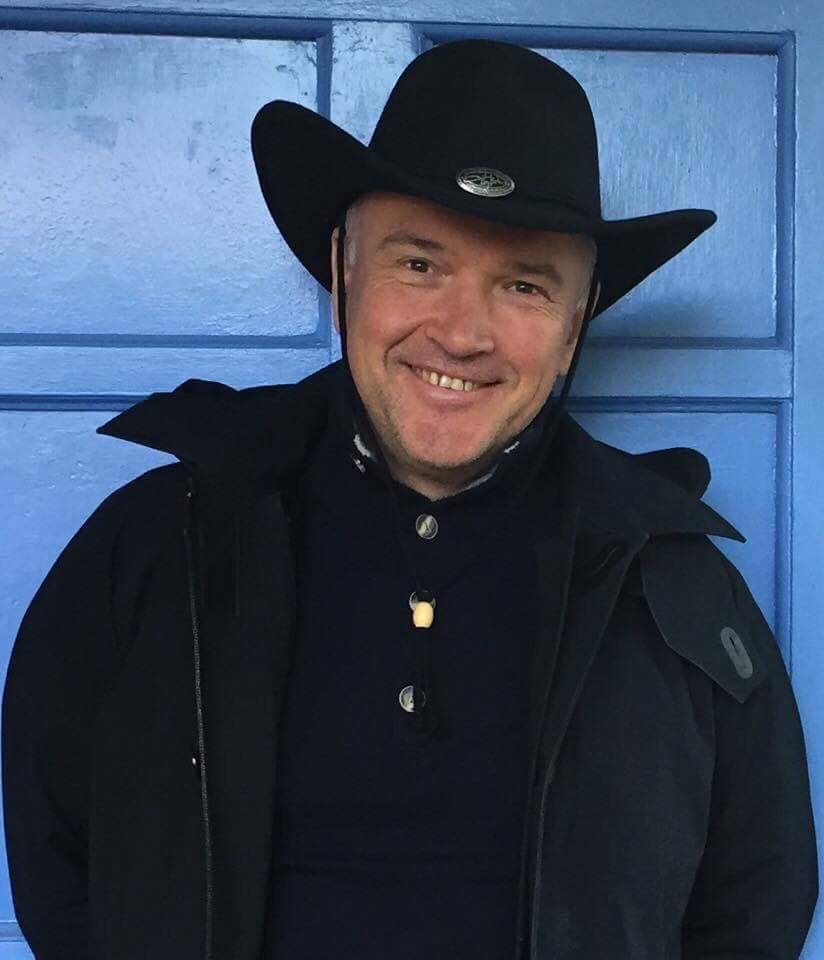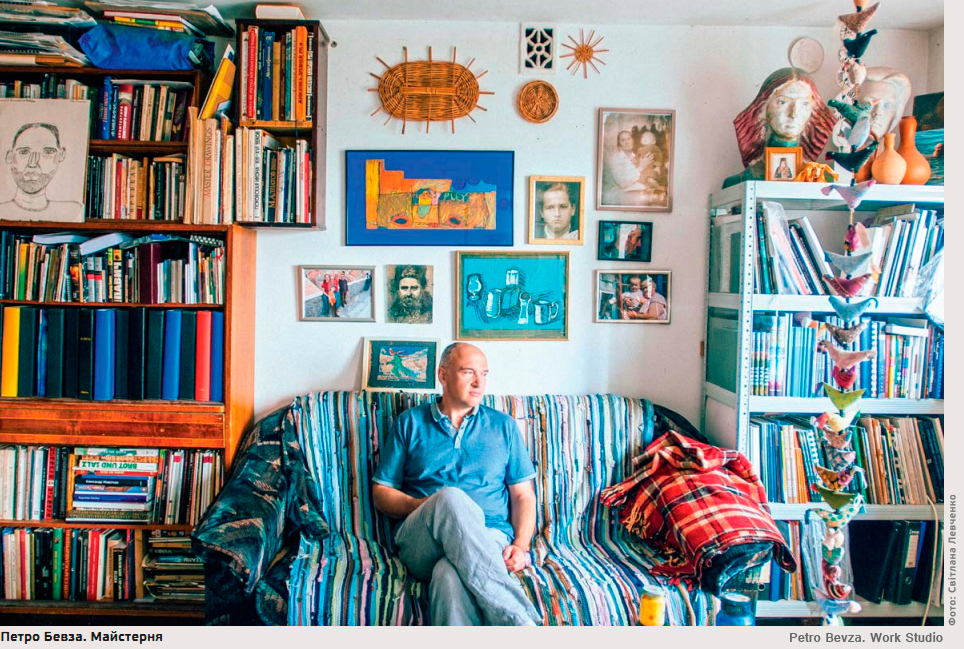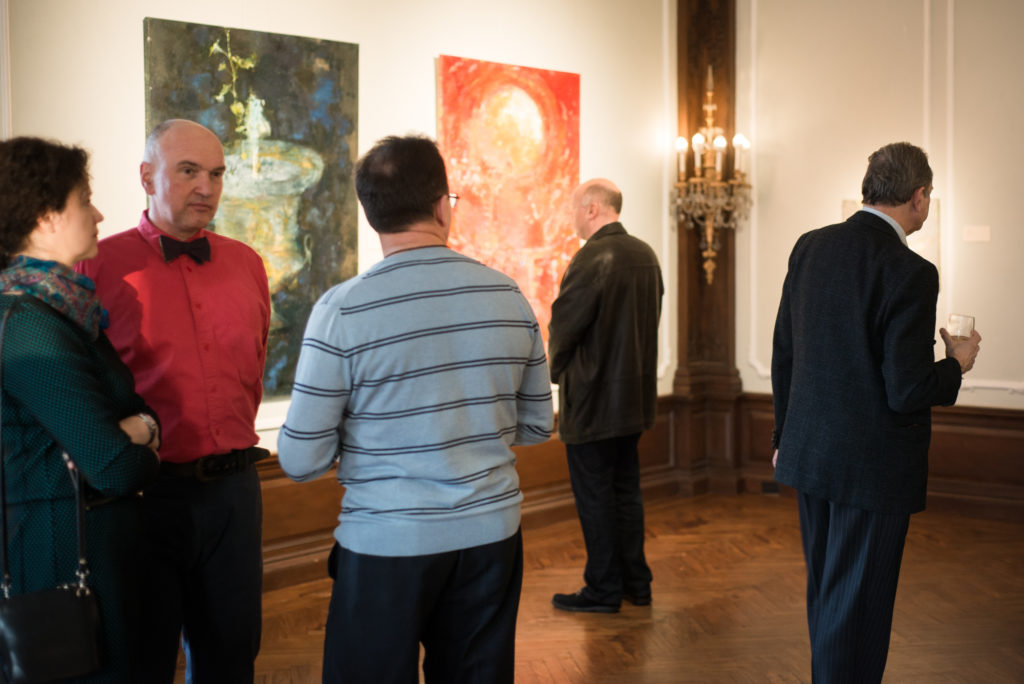Clearly, This Is Not All
Andriy Gurenko
“Creative work is practiced in a parallel time of solitude, but in a way that brings about the quality of the unexpected, when the author’s time is resynchronized with the time of the audience”
B. Groys, “In The Flow”
Petro Bevza’s new “Another One” has marked the beginning of a new eloquent language, an unexpected new way of viewing the world. Indeed, if one is to compare these paintings with those from previous series, for example, with “Theodosics” [1] or “Jordan” [2] – the changes are obvious. The graceful departure from the artist’s established recognizable style induces not only fascination and awe. The power of mysterious images, the brightness and freshness of the renewed palette awaken both an emotional reaction in the neophyte viewer as well as a curiosity in the hermeneutical researcher. This is a good opportunity to examine the artist’s work in a broader context than that of individual exhibitions. [3]
B. Groys once articulated the idea of a “common horizons of events”. Among other things, it denies the paradigmatic opposition to modernity – “progress as regression” in the realm of culture. Although Groys was addressing two large – capitalist and socialist – systems, this approach seems to apply to the less general phenomena as well. The emergence of such personalities as Anselm Kiefer, Neo Rauch or Peter Doig against the backdrop of predominating non-objective, conceptual and media art of the Leipzig School, is confirmation of this principle at work in the midst of a seemingly homogeneous body of contemporary art. For Ukrainian realities this is a good recipe against the traumatic postcolonial discourse. Not the only one, given the urgent need to fill in the institutional and infrastructure gaps, but pointing to another important resource for change – the artist’s consciousness.
In Petro Bevza’s case, the “common horizon of events” transforms into a personal dialogue. Various dedication works as well as the author’s numerous publications clearly define the circle of interests as well and the importance of a constant inflow of professional and worldview-conceptual knowledge. This is oxygen to the lungs of inspiration, which keeps one from congealing and mothballing their own conjuncture.
Bevza likes finding emotional resonances, points that stir up imagination and emotions. This is indirectly evidenced by the number of thematic cycles carried out, one of the first of which is eloquently titled “Ecstasy” (1990-92). The crazy desire to be filled with the world as much as possible, in all of its manifestations – this forms the artistic route, the logbook pages of which are paintings, objects, and videos. Fortunately, his inner romantic navigator avoids the dangerous reefs of orgiastic indiscriminateness and self-indulgence. The name “Ecstasy” can be interpreted as a kind of motto for a creative movement, but the starting point of the journey that led to the current transitory intermission is clearly the project «Ce’st moi. The Reality of Abstraction” [4]. In the catalog to it Serhiy Krymsky wrote: “Petro Bevza turns to the primordial world – a monolith, where all malleable forces are in balance. When he takes a paint and strikes with it, the monolith erupts a plastic energy, with which the artist works.” The plastic energy of the environment, of an undivided, homogenous world, unleashes like a raw natural force, like magma it erupts in strokes and colored arrays on the canvas, and resonates with the energy of youth. This is a time of first successes, a time when it’s easy to write manifestos and paintings like “The Birth of Wind” (1994).
In retrospect, under closer examination, you can trace all the “ports” to which this wind directed the artist, the signs that pointed him to the way, who was with him for parts of the journey. With a Renaissance ingenuousness free from the traps of Enlightenment, everything is inspiration for creativity: a flower and a woman, a landscape and a feeling of kinship with an artist of a different era or country, an agricultural tool and fog, a read book and the drip of paint on a tile. We can imagine that with each new series of works, the artist, like an experienced treasure hunter, marks his found treasure on the map of his imagination, and the more complex the discovered world becomes, the more of them he discovers. The logic of the genre would have it that these markings be encrypted. Who then is the addressee of this visual-virtual message? The viewer, of course, but the name of the project «Another One” hints to another, less obvious, but likely candidate.
Previously mentioned B. Groys noted “utopianism” as a characteristic feature of artistic creativity, referring to its quality of being “here and now” and at the same time oriented toward the future. The characteristic feature of Peter Bevza, in my opinion, is his striking quality of being himself instead of equating to himself. A powerful pulsation of movement forward occurs between the difference of potentials – how he is and how he can be (i.e. the artist). Therefore, “Another One” is the point where «Ce’st moi. The Reality of Abstraction” – and everything between these two projects – is read metaphorically. “Another One” is a white spot of an unknown land, an abstraction of the future, the potential likelihood of a future set in the reality of 1995. In “Another One” we also see a world deconstructed and studied for 23 years, then re-constructed again and encrypted on the foundation of life and professional experience. It’s in this context that we can understand the new appeal to non-objectivism, the revived sense of wondrous spatial endlessness. Hence alluding and enigmatic titles like “The Angel and the Camouflage Net” (2017). The raw natural force of the nineties is transformed in 2018, but it hasn’t lost its power. She trembles and vibrates in exquisitely ordered elegant forms.
Using the “dialogue” concept related to Bevza, we can compare the traveled journey with the evolution of a megalith to a Corinthian column. The utopia of “Another One” can be perceived as a kind of response to Fritz Lang’s “Metropolis”, having the same measure of scale and completeness. The difference between them, however, is in their interpretation of the future. Bevza claims it’s possible not to lose the vividness and taste of life in an organized world and that the later is not necessarily a threat. The future lies not in the black and white steel shine of the conveyor belt, but in the bright colors and patterns of a flower, in digital abstraction that helps realize individual desires. This combination of innovative pragmatism and desired poetics results in exceptionally high-quality painting.
The influences of plasticity in Petro Bevza current art should be sought in his works from 1996-2000. In 1994 the series of semi-abstract landscapes, marked only by Roman numerals with “Way 1, 2, .. 5”, demonstrates a certain distance between the author and the world as the object of study and artistic representation, as well as the already mentioned “monolith” of Serhiy Krymsky. Two years later, this distance is radically reduced, the environment is charged at. It’s as if all sensory signals are instantly encoded into painting without any reflective pause. It’s then that we witness the formation, mostly by intuition and under the influence of temperament, a unique way of artistic transmission: the textured, generous underpainting is layered with a bold structure of active zigzaged lines projected into array of paints – emotion embodied in gesture. The dominating colors are light yellowish-burgundy. A mixture of oil paint with sawdust resembles clay and soil not only via pigment but also by texture. The invented method does not revert to a simple formal technique. The artist doesn’t so much depict but rather recreates anew the emotional framework and outlines of forms in the living space.
The euphoria of youth enhances the acute sense of staying in the midst of an existential belief, a weighty background for which serves the social evil and the shift of 90s. The total impressions provoke to test the found optics in all things and phenomena. Hence the fluctuations from “Transformation of the Views” to “World of the Hen” and “World of Spider” (all 1996). This physically tangible pleasure from the tactility of the surrounding environment practically explodes into a rectangle of canvases. But in addition to an instantaneous flash from the touch to the reality of the detected sensitive internal oscilloscope of the artist in these paintings, there is the opposite pole of metaphysical-mythological continuity. The metaphor of clay, as the mythological first material, combines temporal and spatial opposites in the act of demiurgic creation-reincarnation. Therefore, “Chicken World” and “Transformation of the Views” are equally cosmic in scale. The feeling of materiality of the world as a materiality of oneself as an artist is spontaneously mergent, inseparable and directly appealing to the viewer.
In the 1998 series “Communicative Corridor”, the following important stage takes place. Delayed continuity is already felt as a certain field, the overall impression is concentrated in specific image-signs and interaction between them. Agricultural tool – a hay rake evolves from a practical object to a virtually sacred attribute. What’s important here is the transformation process itself, due to which the subject of the image partially loses, changes its form by obtaining new properties. And if the hay rake of 1998 is still material, filling, the picture of the amaryllis in 2018 is present as a hint, only in the form of a shimmering contour similar to a solace lightning. The generalization does not mean abandonment, for Bevza it’s extremely important to preserve a personal, even intimate, starting point of a creative impulse. This may be mentioned in the title “Kyiv-Berlin” (2017) or a color strip that reminds of a certain place. The bridge of understanding, the actual communicative corridor of nonverbal communication is open and at the same time, as in the classical garden of stones, always has one more hidden stone-content. This one image is able to combine and simultaneously spread the set of opposing states and contents from paphos to lyrics. Reading and reflection complicate the time-structure of canvases, the dimension of the “breathing” of different parts is lined up one by one creating their own non-linear time measurements. The magnitude of this vision is not physical, it doesn’t depend on the actual size. The space of contemplation consists, at least, of three components: the interior time of the artist from the impression to the finished work, the internal time of contemplation of the viewer, and the flow of time between the elements of the image. “Mountain” (1999), “The Communicative Corridor” (1998), “Dedication to Tapies” (1998), are variations of one motive but with two elements – hay rakes and fields are just enough to form a different universe every time.
The level of the variational-combinatorial potency of the cycle “Another One” is in order, and maybe, somewhat higher than the predecessors. In comparison to Mondrian, who received his rectangles by reducing the structure of the branches of a tree, Bevza seems to take the opposite course. However, this is not an arbitrary “multiplication of entities”. Outlines of the world have changed and the artist, with his time-tuned radar, is trying to catch the essence of the present. Over the past twenty years, new trees have grown, chronological albums with geotagging have replaced CDs with digital photos, people are hiking while reusable missiles are being launched into space, and sometimes the expanses of modern computer games look more convincing than the landscape outside the window. Materiality is no longer an absolute measure of reality. As if the reflection of this chaotic all-permeability of the newly formed networks, the crazy mix of archaic and futuristic inclusions, and the geometry of the space of new paintings is similar to origami. The picturesque plane in them is superimposed, bends, coincides with the folds, illuminates the holes in the unknown distance ignoring both the classic horizon line and the rigid 3D axonometry of architectural editors. From the outside it looks like a capricious collage, an unknown dance of colored fragments. The trajectories of their movement are sometimes reminiscent of refined mathematical functions or flight patterns. If you try to imagine a picture with the projection of personal time, the evolution of artistic means will appear as an infographic of the development tree of creativity. The streams of 1996 will resemble shoots that break through the thickness of the earth, the “Communicative Corridor” 1998, with its slow telluric plasticity, will become the roots and barrels, and the “Another One” – the branches and the crown through which the kaleidoscope of the fragments of the present and the future shines.
Bright yellow, blue, purple, and dark blue – in 2018 the colors have almost sprouted in the plowed field of the 1998 ocher. Optically enhanced boundaries of vision is a way to increase the number in directions of vision and information parameters. The artist doesn’t distance himself from the subject, he simply sees more and more precisely, the forms become clear and exquisite, and the colors are bright and clean. Same as before, he finds a personal metaphorical-subject key to fix his “here and now.” The crumbling amaryllis flower and the digital image editor become Bevza’s the two main tricks of his new look. To choose one thing is to cut the world in half and make it flat and uninteresting. By combining the natural and technological entities, their visual synthesis allows you to find the individual harmony of the rhythm. Thanks to him, even fragments of the “big picture”, that we are given to see and feel, will sound like a well-tuned melody. The ease and freshness of this rhythm is the most convincing way to be open and to remain original. Remains in the dialogue with Alexander Archipenko and Antoni Tapies, and resonates with Graham Sutherland and Julie Mehretu.
A tuned in spectator can easily imagine the picture “To the Greates” (2017) by Georgia’s O’Keefe’s meeting with Hokusai, and to see how emotions animate the shadow in Pygmalion (2018). “I know everything” – signs the artist under another piece. You can’t not believe him but not everything can be unraveled and written, and when text is translated something substantial always gets lost. The new world is only waiting to be read. Perhaps certain words and concepts don’t exist yet, maybe they’re only on their way to us. We hope that in the end there will be not one but three points: “possibility”, “probability”, “continuity” … The artists permanent attraction to iconographics hints that there’s a chance to understand. It will be necessary (how else) to make efforts, because otherwise, it’s unlikely that the past experience will be useful. It’s not necessary to require a clear and simple message because simplification is a path of entropy, and the artist offers a complicated and unknown, but also a perfected harmony in which what was understood today can thrive. The hints are scattered in the names and can be put into a guide. Or into a verse:
When “Following the inner light”
Dance their “Dance”
In the “Lunar Landscape” from “Maelstrom” “Comes Tomorrow”,
Like Journey of yellow flamingos“.
And here! It’s “Already Here!”
Obviously, this is not all. Wishing to wait for the following pictures – “Rows”, because the “Time Machine” has already been created.
[1] “Theodosics” – a cycle of paintings, in which Petro Bevza worked in 2002-07, based on impressions of travels in south-eastern Crimea, in particular the region of Great Feodosia. Exhibitions of the Theodosics cycle were exhibited at the Mystetskyi Arsenal (Kyiv, Ukraine, 2016), the Ukrainian Institute of America (New York, USA, 2016), Bezpala Brown Gallery (Toronto, Canada, 2010), Sumy City Gallery (Sumy, Ukraine, 2009). Gallery Gamla Vaster (Malme, Sveden, 2006, 2008), Center for Contemporary Art “Dzyga” (Lviv, Ukraine, 2005), Kharkiv City Gallery (Kharkiv, Ukraine, 2004), Karas Gallery (Kyiv, Ukraine, 2002-07) ) Texts to catalogs were written by Oleg Sydor-Gibelinda.
[2] “Jordan” is an art project by Peter Bevza, which included a series of paintings “Anno Domini”, “Jordan” and “Theodosics”. Exhibitions were held at the Ukrainian Institute of America (New York, USA), the National Museum of Decorative and Applied Arts of Ukraine (Kyiv, Ukraine), the N2N Gallery (Abu Dhabi, UAE), the Contemporary Art Center “White World” (Kyiv, Ukraine). ), Odessa Art Museum. (Odessa, Ukraine), Sheptytsky National Museum Lviv, Ukraine). The texts were cataloged by Walter Hoydysh, Volodymyr Gorbatenko and Oleg Sydor-Gibelinda.
[3] Pictures of the painting cycle «INNY / Another One», on which Petro Bevza worked in 2015-18, were exhibited at the Karas Gallery (Kyiv, Ukraine) at the “Ambiguous abstractions” exhibitions, 2016, “Twirl”, 2017 and “Penetration”, 2018.
[4] “Petro Bevza. C`est moi. Reality of Abstraction” – personal exhibition in National Art Museum of Ukraine (Kyiv, Ukraine, 1995). The texts were cataloged by Serhiy Krymsky, Olha Lagutenko,Sophia Ivanenko and Aaron Koupland



